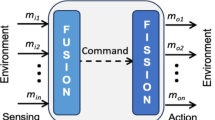Abstract
Purpose
To investigate fixation behavior in eyes with advanced glaucoma using the MicroPerimeter MP-1.
Methods
We retrospectively reviewed 39 glaucoma patients who had scotomas adjacent to fixation points. Using the MP-1, we examined the stability and location of fixation with the fixation test and the microperimetry test. We examined retinal sensitivity using the central 10–2 SITA standard programs of a Humphrey Field Analyzer and the macula 10° program of the MP-1 and analyzed the correlation between fixation behavior and retinal sensitivity.
Results
Of the 39 eyes, 37 showed “stable” fixation in the fixation test, while 30 eyes showed stable fixation in the microperimetry test. In the fixation test, 32 of 39 eyes demonstrated “predominantly central” fixation, whereas in the microperimetry test only 26 eyes exhibited the same fixation. Fixation stability correlated positively with sensitivity in the central 10° diameter area (r = 0.414, P = 0.009). Among the six eyes showing “predominantly eccentric” fixation, the preferred retinal locus of five was in the superior or superotemporal direction from the fovea.
Conclusions
The MP-1 illustrated the fixation patterns in glaucomatous eyes and the fixation patterns correlated well with retinal sensitivity.
Similar content being viewed by others
References
Quigley HA. Number of people with glaucoma worldwide. Br J Ophthalmol 1996;80:389–393.
Iwase A, Araie M, Tomidokoro A, Yamamoto T, Shimizu H, Kitazawa Y. Prevalence and causes of low vision and blindness in a Japanese adult population: the Tajimi Study. Ophthalmology 2006;113:1354–1362.
Midena E, Radin PP, Pilotto E, Ghirlando A, Convento E, Varano M. Fixation pattern and macular sensitivity in eyes with subfoveal choroidal neovascularization secondary to age-related macular degeneration. A microperimetry study. Semin Ophthalmol 2004;19:55–61.
Fletcher DC, Schuchard RA. Preferred retinal loci relationship to macular scotomas in a low-vision population. Ophthalmology 1997;104:632–638.
Kube T, Schmidt S, Toonen F, Kirchhof B, Wolf S. Fixation stability and macular light sensitivity in patients with diabetic maculopathy: a microperimetric study with a scanning laser ophthalmoscope. Ophthalmologica 2005;219:16–20.
Fujii GY, de Juan E Jr, Sunness J, Humayun MS, Pieramici DJ, Chang TS. Patient selection for macular translocation surgery using the scanning laser ophthalmoscope. Ophthalmology 2002;109:1737–1744.
Guez JE, Le Gargasson JF, Massin P, Rigaudiere F, Grall Y, Gaudric A. Functional assessment of macular hole surgery by scanning laser ophthalmoscopy. Ophthalmology 1998;105:694–699.
Sabates NR, Crane WG, Sabates FN, Schuchard RA, Fletcher DC. Scanning laser ophthalmoscope macular perimetry in the evaluation of submacular surgery. Retina 1996;16:296–304.
Rohrschneider K, Springer C, Bultmann S, Volcker HE. Microperimetry—comparison between the Micro Perimeter 1 and scanning laser ophthalmoscope-fundus perimetry. Am J Ophthalmol 2005;139:125–134.
Springer C, Bultmann S, Volcker HE, Rohrschneider K. Fundus perimetry with the Micro Perimeter 1 in normal individuals: comparison with conventional threshold perimetry. Ophthalmology 2005;112:848–854.
Midena E, Vujosevic S, Convento E, Manfre A, Cavarzeran F, Pilotto E. Microperimetry and fundus autofluorescence in patients with early age-related macular degeneration. Br J Ophthalmol 2007;91:1499–1503.
Anderson DR, Patella VM. Automated static perimetry. St. Louis: Mosby; 1999. p. 152–153.
Deruaz A, Whatham AR, Mermoud C, Safran AB. Reading with multiple preferred retinal loci: implications for training a more efficient reading strategy. Vision Res 2002;42:2947–2957.
Matsumoto Y, Yuzawa M, Oda K. How spatial orientation of Japanese text affects fixation points in patients with bilateral macular atrophy. Jpn J Ophthalmol 2005;49:462–468.
Sawa M, Gomi F, Toyoda A, Ikuno Y, Fujikado T, Tano Y. A microperimeter that provides fixation pattern and retinal sensitivity measurement. Jpn J Ophthalmol 2006;50:111–115.
Lei H, Schuchard R. Using two preferred retinal loci for different lighting conditions in patients with central scotomas. Invest Ophthalmol Vis Sci 1997;38:1812–1818.
Fujii GY, De Juan E Jr, Humayun MS, Sunness JS, Chang TS, Rossi JV. Characteristics of visual loss by scanning laser ophthalmoscope microperimetry in eyes with subfoveal choroidal neovascularization secondary to age-related macular degeneration. Am J Ophthalmol 2003;136:1067–1078.
Mori F, Ishiko S, Kitaya N, et al. Scotoma and fixation patterns using scanning laser ophthalmoscope microperimetry in patients with macular dystrophy. Am J Ophthalmol 2001;132:897–902.
Vujosevic S, Midena E, Pilotto E, Radin PP, Chiesa L, Cavarzeran F. Diabetic macular edema: correlation between microperimetry and optical coherence tomography findings. Invest Ophthalmol Vis Sci 2006;47:3044–3051.
Carpineto P, Ciancaglini M, Di Antonio L, Gavalas C, Mastropasqua L. Fundus microperimetry patterns of fixation in type 2 diabetic patients with diffuse macular edema. Retina 2007;27:21–29.
Crossland MD, Culham LE, Kabanarou SA, Rubin GS. Preferred retinal locus development in patients with macular disease. Ophthalmology 2005;112:1579–1585.
Sunness JS, Applegate CA. Long-term follow-up of fixation patterns in eyes with central scotomas from geographic atrophy that is associated with age-related macular degeneration. Am J Ophthalmol 2005;140:1085–1093.
Sunness JS, Applegate CA, Haselwood D, Rubin GS. Fixation patterns and reading rates in eyes with central scotomas from advanced atrophic age-related macular degeneration and Stargardt disease. Ophthalmology 1996;103:1458–1466.
Guez JE, Le Gargasson JF, Rigaudiere F, O’Regan JK. Is there a systematic location for the pseudo-fovea in patients with central scotoma? Vision Res 1993;33:1271–1279.
Nilsson UL, Frennesson C, Nilsson SE. Patients with AMD and a large absolute central scotoma can be trained successfully to use eccentric viewing, as demonstrated in a scanning laser ophthalmoscope. Vision Res 2003;43:1777–1787.
Author information
Authors and Affiliations
Corresponding author
About this article
Cite this article
Kameda, T., Tanabe, T., Hangai, M. et al. Fixation behavior in advanced stage glaucoma assessed by the MicroPerimeter MP-1. Jpn J Ophthalmol 53, 580–587 (2009). https://doi.org/10.1007/s10384-009-0735-y
Received:
Accepted:
Published:
Issue Date:
DOI: https://doi.org/10.1007/s10384-009-0735-y




